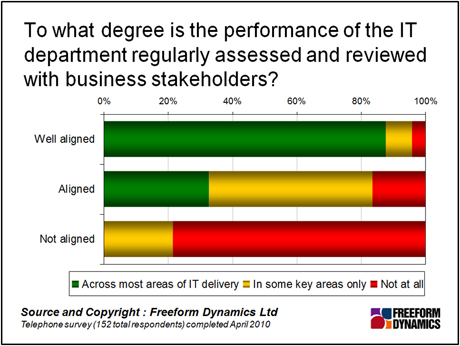Usually when we think of IT performance, we focus on the physical. We ask questions such as, “How fast is it?” or “Why did it take so long to recover from that problem?”. But looking at the bigger picture and considering how IT slots into the business, performance is also about assessing IT’s fitness for purpose.
It is interesting to see how the senior management of different companies view the IT function. In a survey we conducted in the first half of 2010 looking at companies ranging from 1,000 to 10,000 employees, we asked IT systems management professionals for their views on how senior management viewed their function:
- Some 32 per cent of respondents describe themselves as ’well aligned’, where IT is seen as an enabler of business innovation and advantage.
- Some 40 per cent said they are ’aligned’, where IT is seen as a positive driver of operational efficiency.
- Some 28 per cent view IT as ’not aligned’, where IT is seen as a necessary cost.
From these figures we see that in the centre ground IT is viewed as generally being aligned with the business. But beyond that centre ground, for every company where management values innovation in IT, there are just as many companies where IT is seen as a cost burden.
Managers may see IT as not aligned for many reasons but there is a shared responsibility on both the business and IT to come together and tackle the issue.
IT more aligned with business can justify investment
Senior business management’s view of IT also has important implications for the strategic view of IT itself. Historically, IT departments have concentrated more on systems and applications, than the services they provide. In organisations where IT is well aligned with the business, the focus changes from viewing IT as individual applications, to defining IT in terms of the service delivered to the business.
We know from a number of research studies that IT organisations that are seen as better tuned into the needs of the business find it easier to justify investment in the advanced tools, techniques and processes that can be used to improve the effectiveness of the applications and services that IT delivers.
Meanwhile, IT organisations that are seen as a necessary cost can also be the ones for whom investment, and ultimately service delivery, suffers.
This split in opinion on the alignment of IT to the business might seem to be an obvious bell-curve result, but the impact is far reaching. Looking at how the end-user community views things shows exactly why this is.
Those organisations where IT is well aligned tell us of highly positive end-user perceptions of IT services. In fact, almost 90 per cent had a positive end-user experience in general and 50 per cent rated it is highly positive.
Perceived satisfaction drops rapidly as IT become less well aligned with the business. Just over half of companies where IT is aligned with the business have a positive rating, and this drops to only 15 per cent where IT is not aligned with the business…
Changing the user experience from negative to positive requires firm and determined action. The IT department can start this process on its own, for example, by adopting structured systems management and thinking of IT in terms of service delivery. But ultimately it needs to engage with the broader business to succeed. However, one of the key areas to concentrate on is one that is sorely lacking in many companies.
HR departments and managers routinely practise performance management, and in particular setting objectives and looking at the results achieved. The findings of our survey show that in many cases, IT is effectively operating as a black box that is not well understood by the business, and which does not itself understand the business.
The IT department is operating either blind or partially sighted with respect to the needs of the business, and many companies are throwing money at IT with no realistic way of measuring the value they receive in return.

Performance assessment and review
It is also evident that performance assessment and review is a key enabler of business alignment, and developing this relationship between the business and IT should be a priority. This process will involve engaging with senior management and department heads as part of the day-to-day planning and operations, as well as involving IT early in major company strategies and decisions.
Enabling a framework for the objective assessment of the delivery of IT services is vital. Developing a range of key performance indicators (KPIs) will be important. Monitoring and reporting on the KPIs will act as a positive feedback loop on how IT is delivering against the expectations of the business.
Provided IT is able to modify its approach based on performance against these KPIs, through investment, training or otherwise, then IT will be well on its way to increasing its importance to the business as well as having a pool of much happier end users.
Content Contributors: Josie Sephton
Through our research and insights, we help bridge the gap between technology buyers and sellers.



Have You Read This?
Generative AI Checkpoint
From Barcode Scanning to Smart Data Capture
Beyond the Barcode: Smart Data Capture
The Evolving Role of Converged Infrastructure in Modern IT
Evaluating the Potential of Hyper-Converged Storage
Kubernetes as an enterprise multi-cloud enabler
A CX perspective on the Contact Centre
Automation of SAP Master Data Management